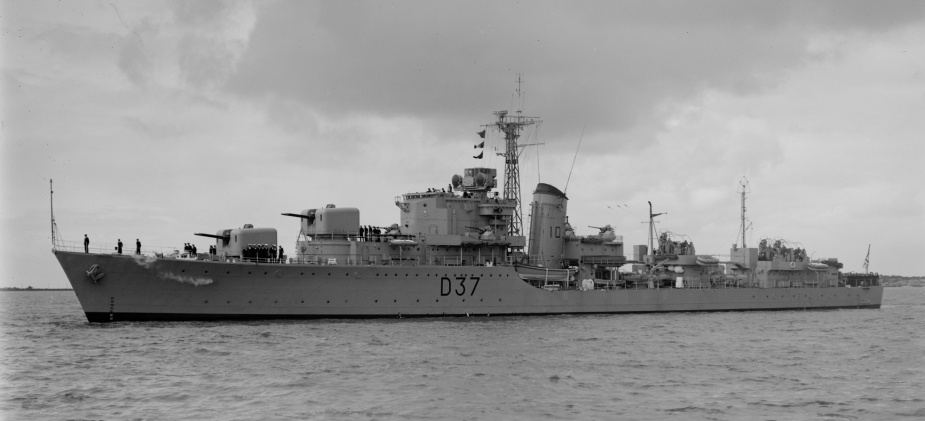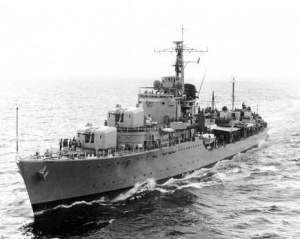Referring to Tobruk, the Flag Officer Second-in-Command, Far East Station, Rear Admiral A.K. Scott-Moncrieff, RN said ‘it had recently made its presence known to the Communist Forces in Korea.’ ‘Fitted with the very latest gunnery equipment,’ he added ‘it has carried out pin-point bombardments on both coasts of Korea and has hit trains, railways, railway bridges and troop concentrations. During the 118 days it operated in the Commonwealth Group, Tobruk spent 89 days at sea and steamed about 27 000 miles. During the strike against Munognam in November it was one of the bombarding element which destroyed large areas of military installations. Tobruk returned to Australian waters on 22 February 1952.
Following 6 months in home waters, Tobruk in September 1952 escorted Sydney (III) to Manus Island and during the following month was engaged carrying out security patrols off the Monte Bello Islands, covering the explosion of the first British atomic bomb. The following 7 months were all spent in Australian waters.
Tobruk returned to Korean waters on 26 June 1953 when it reported for duty to Commander Task Unit 95.1.2 (HMS Newcastle) at Taechong Do as relief to HMAS Anzac (II) for west coast operations. On 27 June it joined the screening force covering the carrier HMS Ocean. This duty continued until Ocean was relieved by USS Bairoko on 5 July.
Tobruk’s next mission was with Task Group 95.2 as part of the Yangdo Blockade and Patrol Group. It reached Yang Do on 14 July where it relieved HMCS Huron. Operations with this group continued until the close of hostilities on 27 July 1953. On 16 July Tobruk sank a large motor sampan suspected of operating as a mine-layer. It fired its last shots of the war on 24 July when it fired a few rounds of 4.5-inch ammunition at a radar post installation on Musudan Point between Chongjin and Yang Do.
Although hostilities ended on 27 July 1953, Tobruk continued to serve in Korean waters in the postwar period, conducting post Armistice patrols until January 1954. During its second tour of duty in Korean waters it steamed 26 000 miles, including some 7,000 miles before the end of hostilities.
After a refit in the early part of 1954 it operated in Australian and New Guinea waters until June 1955 when it exercised with the fleet in Southeast Asian waters.
In June and July 1955 Tobruk served as a unit of the Far East Strategic Reserve, taking part in joint exercises. The succeeding years saw Tobruk return to the Far East on a number of occasions as part of the Australian commitment to the Far East Strategic Reserve.
On 26 April 1957 Tobruk was taking part in a night encounter exercise while participating in SEATO Exercise ASTRA. The opposing forces were designated ‘blue’ and ‘orange’ respectively and the purpose of the exercise was to detect and engage the opposition in a night action environment.
Shortly after 21:00 hours Tobruk was steaming as the third, and rear ship, in a Blue Force column lead by HMS Newcastle steering 340 at 25 knots. HMAS Anzac was the second ship in the column ahead of Tobruk. Each ship was 2000 yards apart. At approximately 21:10, star shell bursts were observed by Tobruk to the west of Anzac as the column was executing a turn together to port, to course 160. Several minutes later Tobruk and Anzac were ordered by Newcastle to form on a line of bearing and the course was altered to 130. At 21:17 reports were issued from Tobruk indicating that shells were falling very close to each side of the ship and shortly afterwards it was hit by a shell that passed inboard through the upper deck into ‘A’ gun bay where it detonated critically injuring 2 sailors: Able Seaman RW Spooner and Able Seaman JR Stevenson. Able Seaman Spooner subsequently died of his wounds.
A board of inquiry into the tragedy revealed that a star shell fired from HMS Cockade during the night encounter exercise was responsible for the damage to Tobruk and its casualties. Able Seaman Robert William Spooner was buried at sea the following day with full naval honours. He is commemorated on the Roll of Honour at the Australian War Memorial, Canberra.
Tobruk continued to operate in south-east Asian waters in 1957, 1958 and 1959. During that time time RAN ships carried out several goodwill visits to the Republic of Vietnam. The first of these occurred when HMAS Anzac (II) visited Saigon in October 1956 for the observance of Vietnamese National Day. It was followed by Tobruk which visited Saigon in December 1957 and Cam Ranh Bay in September 1959. The purpose of these visits was to demonstrate Australia’s support for the ruling non-Communist Vietnamese Government.
During the 1959 deployment an unfortunate incident saw one of Tobruk’s ship-launched torpedos accidentally fired while the tubes were fixed in the fore and aft position. The torpedo entered the after deck house screen lodging itself in one of the ships bathrooms. Fortunately all onboard escaped injury.
Following a refit in 1960, Tobruk joined Anzac (II) for a cruise to Noumea and to various ports in New Guinea. In September 1960, while exercising with the fleet off the east coast of Australia, it was accidentally hit by a shell from Anzac (II). After effecting repairs at Jervis Bay, Tobruk sailed for Sydney where it paid off into Reserve on 29 October 1960. During its service Tobruk steamed 299 946 miles.

